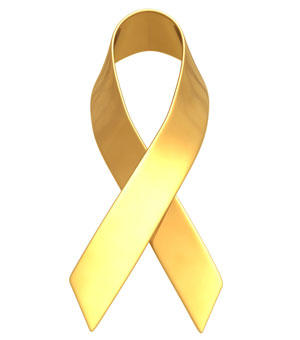Childhood Cancer Awareness Month
September is Childhood Cancer Awareness Month, a time to recognize the children and families affected by childhood cancers and to emphasize the importance of supporting research on these devastating conditions. Since 1947, Dana-Farber Cancer Institute and Boston Children's Hospital have worked together to care for children with cancer and to improve outcomes through cutting-edge research.
This month, and throughout the year, we honor the children currently battling cancer, the families who love them, the clinicians and other caregivers treating them, the survivors of childhood cancer, the children who lost their lives to childhood cancer, and the researchers working to conquer childhood cancer.

Did you know... ?
- Survival rates continue to rise... In 1975, 61 percent of U.S. children with cancer survived. Today, 84 percent do.
- ...but are lagging in less-developed countries. Eighty percent of cases of childhood cancer are in the developing world, where survival averages 20 percent.
- In the 21st century, treatment for cancer is being transformed.
Stories from our childhood cancer patients and clinicians
- Emma and Alexander’s story — Saving his sister’s life: A brother’s bone marrow cells help his sister send a rare form of leukemia into remission.
- Susan’s story — Still flourishing a half century later: When she was just 11 months old, Susan was diagnosed with neuroblastoma. Today, she serves as an inspiration for other patients and survivors.
- Ziad’s story — A pint-sized patient with a huge medical challenge: Ziad heads to Dana-Farber/Boston Children’s after being diagnosed with hepatocellular carcinoma (HCC), an aggressive form of liver cancer rare in children.
- Amelia’s story — Ewing sarcoma patient faces her disease with courage and insight: “I took a bad turn in life, and now I understand what’s going on when other people are struggling with their health and other challenges,” says 12-year-old, Amelia Zai.
- Mayor Walsh's story — From the clinic to the mayor's office: The challenges he faced in his life, including his cancer diagnosis when he was 7, helped fuel Martin Walsh's successful run for mayor of Boston.
Childhood cancer treatment facts and tips
- Why are children more likely to get blood cancers than solid tumors? In children and adolescents, the most common malignancies are blood cancers.
- What is retinoblastoma and how is it treated? Thanks to recent advances, more than 95 percent of children with this rare eye cancer can be cured.
- What genetic syndromes can increase a child’s risk of cancer? Genetic testing can serve a vital proactive role in a child’s health.
- What should you know about pediatric germ cell tumors? These tumors are rare in children under the age of 15 but are the most common solid tumors in adolescents, age 15 to 19.
- What specialists does a child see when diagnosed with cancer? Your child's treatment may involve a whole range of medical experts.
- What should you know when picking a pediatric cancer surgeon? Here are five things to consider.
- What are the top five ways you can help a family whose child has cancer? We asked Jane Roper, whose daughter was diagnosed with acute lymphoblastic leukemia.
- What should you ask when your child finishes treatment? Julia Pettengill, mother of a young leukemia survivor, reflects on the six questions she wishes she'd asked when her daughter completed treatment.
- What should doctors consider when treating childhood cancer survivors? Lisa Diller, MD, lists the five things primary care providers should consider when treating children and adults who have survived a childhood cancer.

 Translate
Translate 